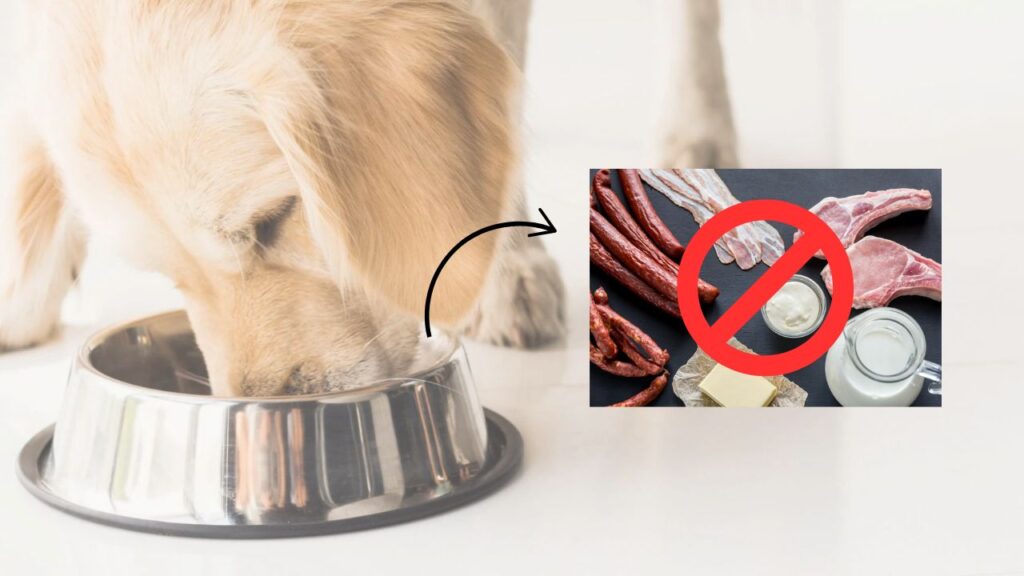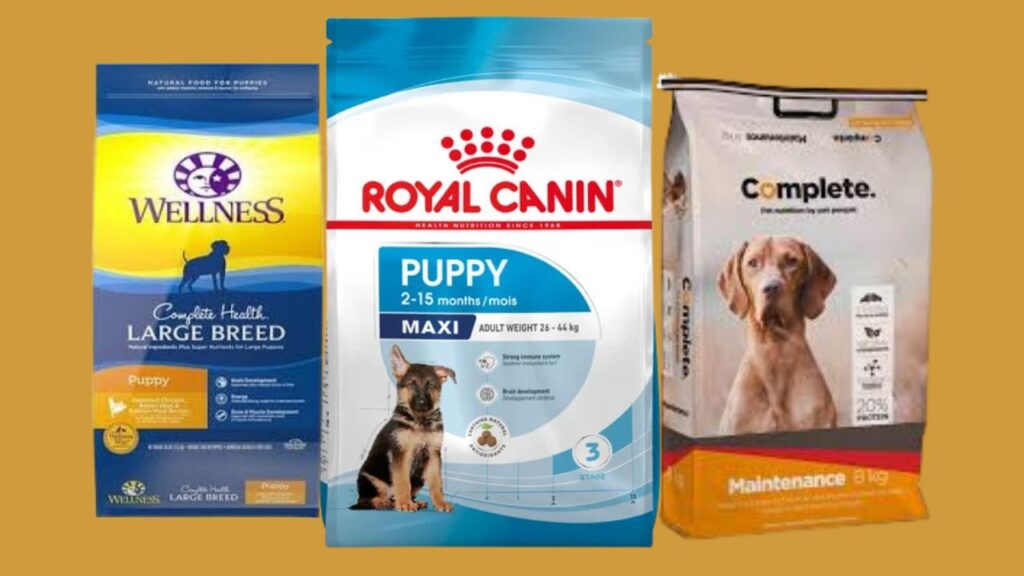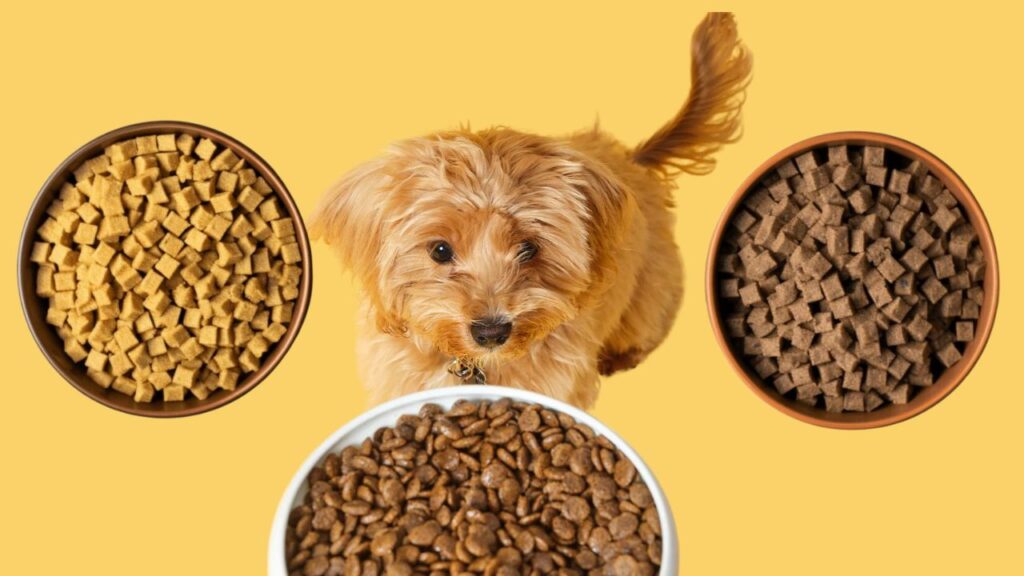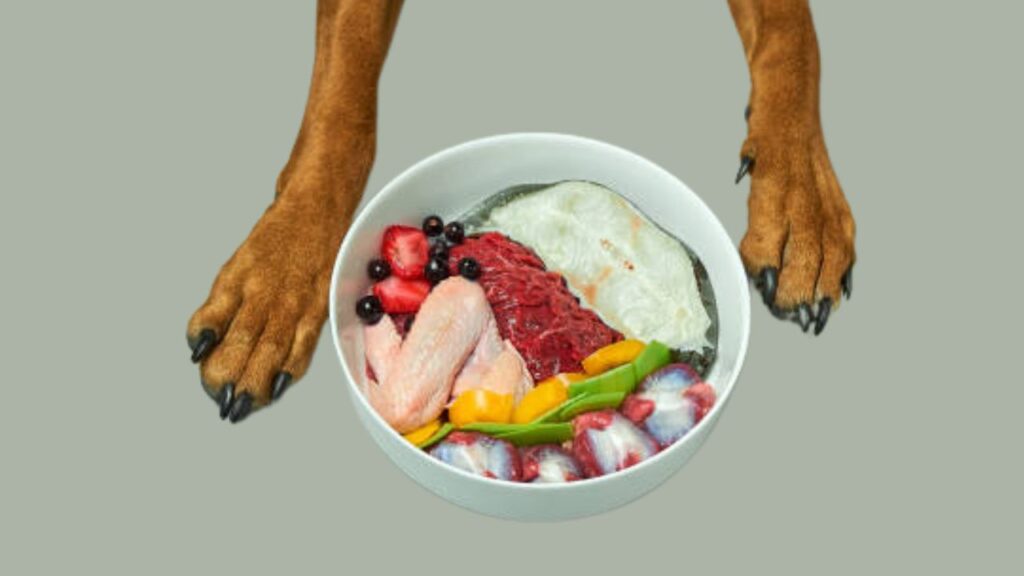When feeding our canine companions, one size certainly doesn’t fit all. Large breed dogs, with their majestic stature and robust build, have unique nutritional requirements that differ significantly from those of their smaller counterparts. The proper diet is imperative for their overall well-being, and “Large Breed Dog Food” caters precisely to these needs. In this comprehensive guide, we’ll delve deep into large breed dog nutrition, helping you make informed decisions that ensure your gentle giant remains healthy, active, and full of life.
This article will serve as your roadmap, from the essential nutrients that fuel their daily activities to the top brands prioritising their unique dietary needs. If you’re specifically looking for the best food options for a Golden Retriever puppy, check out our in-depth guide on the best food for Golden Retriever puppies in the UK. Whether you’re a seasoned dog parent or welcoming a large breed pup into your home for the first time, let’s embark on this journey to discover the best food choices for your beloved pet.
Understanding Large Breed Nutritional Needs
Large breed dogs are not just regular dogs magnified. Their bodies have distinctive demands; understanding these is the first step in ensuring they lead a healthy life. If your Golden Retriever has food sensitivities, finding the right diet for dogs with allergies is crucial. Their size alone dictates several nutritional nuances that must be addressed. Let’s unravel the mystery behind the nutritional needs of large-breed dogs.

- Caloric Intake: Contrary to what many believe, large breed dogs don’t always need more calories. They tend to have slower metabolisms, which means they can gain weight more easily. However, the caloric content should be balanced with their activity level, ensuring they get the right amount without overfeeding.
- Protein Content: Large-breed dogs require a steady intake of high-quality proteins to support muscle maintenance. However, it’s crucial to balance this to prevent excessive puppy growth, which can lead to skeletal issues.
- Fat and Omega Fatty Acids: Essential for skin and coat health, omega fatty acids also support brain and vision development in large-breed puppies. However, the overall fat content should be moderated to prevent obesity.
- Joint Support: Large breeds are prone to joint issues due to their weight and size. Ingredients like glucosamine and chondroitin can be beneficial. They support joint health and can prolong the mobility and comfort of larger dogs.
- Calcium and Phosphorus: These minerals are critical for bone development. In large breeds, it’s essential to maintain these in the right ratio to prevent bone deformities and ensure proper growth.
- Vitamins and Antioxidants: Large breeds can benefit from vitamins like E and C and other antioxidants. These help combat oxidative stress, which large dogs, given their body mass, can be more susceptible to.
Ensuring the “Large Breed Dog Food” you choose addresses these specific nutritional needs is paramount. It caters to their growth and maintenance and can stave off common large breed issues like joint pain, obesity, and cardiac concerns.
In the upcoming sections, we will explore the best dog food brands and products that prioritise these needs, making your choice more straightforward and more informed.
Top Ingredients to Look for in Large Breed Dog Food
When selecting the perfect “large breed dog food,” it’s essential to recognise and prioritise certain ingredients. These key components can make a significant difference in ensuring your large dog gets the best nutrition suited to its unique needs. Here’s a breakdown of some top ingredients that are not just fillers but real nutritional powerhouses for your big canine companion.

- Whole Meat Proteins (Chicken, Beef, Fish, Lamb): Whole meat proteins are superior sources of essential amino acids for muscle growth and maintenance. They ensure robust muscular health without promoting excessive growth in large breeds.
- Brown Rice or Sweet Potato: Complex carbohydrates like brown rice or sweet potatoes are excellent for sustained energy release. They also ensure your dog feels full without unnecessary calories.
- Fatty Fish (like Salmon): Rich in omega-3 fatty acids, fatty fish is a fantastic ingredient for promoting skin and coat health. It also supports cognitive functions and reduces inflammation, which is especially vital for older large breed dogs.
- Glucosamine and Chondroitin: These compounds naturally support joint health, a common concern for larger breeds. Ensuring your dog food includes these can help maintain good joint mobility and reduce discomfort.
- Calcium from Natural Sources (like Bone Meal): Natural calcium sources are better absorbed and utilised. This ensures strong bones without risking excessive mineral accumulation, which can be harmful.
- Vegetables and Fruits (like Blueberries, Spinach, and Carrots): These are excellent sources of essential vitamins, minerals, and antioxidants. They support overall health and immunity and can combat oxidative stress.
- Flaxseed or Fish Oil: Another great source of omega fatty acids, these ingredients can be particularly beneficial for skin health and reducing inflammation.
- Fermentable Fibres (like Beet Pulp) support gut health by promoting healthy bacteria. A healthy gut can improve digestion and nutrient absorption, which is especially crucial for large breeds that require efficient nutrient utilisation.
When choosing ” large breed dog food,” always check the label to ensure it’s rich in these ingredients. Additionally, avoiding foods that list unspecified meat meals, by-products, or excessive fillers is a good idea. After all, quality over quantity is the mantra for feeding your gentle giant.
Up next, stay tuned as we explore the top-rated dog food brands and products that excel at including these essential ingredients so that you’re armed with the best information for your pet’s health.
Ingredients to Avoid in Large Breed Dog Food
While many ingredients can benefit your large breed dog immensely, there are others you’d want to steer clear of. It’s not always just about what’s included in the dog food; sometimes, it’s about what should be left out. Here’s a list of ingredients that can be less than ideal for your large canine companion and why they might not be the best choice.

- Generic Animal Fats: If the fat source isn’t specified (like “chicken fat” or “salmon oil”), it could be from almost any source, including sick animals. Specificity is crucial for quality.
- By-Product Meals: These are often leftovers from meat processing and can contain anything from beaks to feathers and feet. They offer less nutritional value compared to whole meat proteins.
- Artificial Colours, Preservatives, and Flavours are unnecessary and can cause allergic reactions in some dogs. Always opt for natural preservatives like tocopherols.
- Corn Syrup, Sucrose, or Fructose are simple sugars added to make the food palatable. Excessive sugars can lead to obesity, dental problems, and even diabetes in dogs.
- Excessive Fillers (like Corn and Soy): Fillers can bulk up dog food but offer minimal nutritional value. Large-breed dogs need nutrient-rich food, not empty calories.
- BHA, BHT, and Ethoxyquin: These artificial preservatives are known to be carcinogenic in high amounts. Always check for natural alternatives.
- Propylene Glycol: Often used to keep dog food moist, this ingredient can be harmful in large quantities and cause allergic reactions in some dogs.
- Unspecified Meat Meals: Like generic animal fats, if the meat source isn’t specified, it can come from almost any animal. It’s always better to know exactly where the protein is sourced from.
By being a diligent pet parent and actively avoiding dog foods containing these ingredients, you’re making a responsible choice and taking a significant step in ensuring your large breed dog’s long-term health and vitality.
Meanwhile, in the upcoming sections, we’ll highlight some top large breed dog food brands and their offerings, specifically focusing on those that prioritise quality ingredients and your pet’s well-being.
The Role of Life Stages in Large Breed Dog Food Selection
Choosing the right food for your large breed dog goes beyond just looking at the ingredient list. One of the vital factors to consider is your pet’s life stage. Whether your furry friend is a playful puppy, an active adult, or a slow-moving senior, each stage has unique nutritional needs. Here’s how life stages are pivotal in selecting the best Large Breed Dog Food.

Puppy (Growth) Stage:
- Nutritional Needs: Large breed puppies grow rapidly but must do so at a controlled pace to prevent joint and bone issues. They require balanced protein, fat, and nutrients like calcium and phosphorus to support healthy growth.
- Recommended Ingredients: High-quality animal proteins, DHA for brain development, and balanced minerals for bone health.
- Caution: Avoid foods with excessive calcium, as it can lead to skeletal problems in large breed puppies
Adult (Maintenance) Stage:
- Nutritional Needs: Once your large breed dog reaches adulthood, the focus shifts from growth to maintaining an ideal body condition. Adult dogs need a balanced diet with fewer calories than growing puppies.
- Recommended Ingredients: Lean proteins, healthy fats, and complex carbohydrates. Joint supplements like glucosamine can also be beneficial, given the strain large dogs place on their joints.
- Caution: Steer clear of excessive protein or fats, which can lead to obesity.
Senior (Geriatric) Stage:
- Nutritional Needs: As your dog ages, metabolism slows down, and activity might decrease. Seniors often need fewer calories but more fibre and specific nutrients to support joint health and overall well-being.
- Recommended Ingredients: Easily digestible proteins, omega fatty acids for skin and coat health, and antioxidants for immune system support.
- Caution: Watch out for foods that are too high in calories, which can cause weight gain in less active senior dogs.
While ingredients are paramount, it is crucial to select a large breed dog food that aligns with your pet’s current life stage. This approach ensures that your canine companion gets the nutrition needed to thrive during each phase of life.
Best Large Breed Dog Food Brands
When it comes to feeding our large breed dogs, only the best will do. With their unique nutritional requirements, it is imperative to select a brand that understands and caters to their needs. Here, we highlight some of the best large breed dog food brands in 2025.

Arden Grange:
- Overview: With its roots in the UK, Arden Grange offers hypoallergenic dog food with natural ingredients.
- Key Features: Free from wheat, beef, soya, and dairy. Includes prebiotics, joint supplements, and Omega fatty acids.
- Customer Feedback: Many pet owners report increased vitality and fewer allergic reactions with this brand.
Wellness Core:
- Overview: Wellness Core emphasises high-protein, grain-free formulas tailored for optimal health.
- Key Features: Contains premium proteins, antioxidants, probiotics, and essential minerals.
- Customer Feedback: Dogs love the taste; many owners note improved coat shine and energy levels.
Purina:
- Overview: Purina, A renowned pet food industry name, offers tailored nutrition solutions for large breeds.
- Key Features: Made with real meat or fish, supported by essential vitamins and minerals to ensure a balanced diet.
- Customer Feedback: Owners appreciate the brand’s dedication to research and the noticeable health benefits for their pets.
Wagg
- Overview: Wagg is a well-loved brand in the UK, known for its no-nonsense approach to nutrition.
- Key Features: It contains essential Omega 6 & 3 fatty acids and yucca extract to reduce odour from flatulence.
- Customer Feedback: It’s a hit among dogs for its flavour, with owners appreciating its affordability and comprehensive nutrition.
Royal Canin:
- Overview: Royal Canin specialises in breed-specific formulas and offers precise nutrition for large breeds.
- Key Features: Tailored kibble shape for each breed, enriched with EPA & DHA for joint and bone support.
- Customer Feedback: The breed-specific approach is a winner, with noticeable improvements in digestion and overall vitality.
Iams:
- Overview: Iams offers a proactive and balanced approach, ensuring large breed dogs get the nutrition they deserve.
- Key Features: Contains high-quality proteins and essential minerals, and includes a fibre blend for digestive health.
- Customer Feedback: Many pet owners report their dogs have healthier coats, increased energy, and better digestion with Iams.
Selecting from the best large breed dog food brands ensures your beloved pet gets nutrition tailored to its unique needs. Always transition foods gradually, and consult your veterinarian for any specific dietary requirements.
Large Breed Dog Food: Grain vs. Grain-Free Debate
One of the most hotly contested topics in dog nutrition in recent years has been the debate between grain-inclusive and grain-free diets, especially for large breeds. With passionate arguments on both sides, it can be challenging for dog owners to make an informed choice. Here, we delve into the grain versus grain-free debate for large breed dog food.

Understanding Grain-Inclusive Diets:
- Natural Energy Source: Grains like rice, barley, and oats provide dogs with essential carbohydrates, which serve as a primary energy source.
- Nutritional Benefits: Whole grains contain nutrients, including fibre, essential fatty acids, and protein.
- Digestibility: Most dogs digest grains well, which can be a beneficial part of a balanced diet.
- The Case for Grain-Free Diets:
- Allergy Concerns: Some dogs have grain allergies or sensitivities, which can cause skin irritations, digestive issues, and other health problems. For these dogs, grain-free diets can be beneficial.
- Alternative Carbohydrates: Grain-free dog foods often replace grains with other carbohydrate sources like sweet potatoes, peas, or lentils.
- Perceived Natural Diet: Advocates argue that dogs’ ancestral diets didn’t include grains, thus promoting grain-free as a more “natural” choice.
Concerns with Grain-Free Diets:
- Dilated Cardiomyopathy (DCM): Some research suggests a potential link between grain-free diets and DCM, a heart condition, especially in large breeds. However, more studies are needed to establish a direct connection.
- Nutritional Imbalance: Not all grain-free diets are created equal. Some may lack essential nutrients or be imbalanced, potentially leading to health issues.
- Making an Informed Choice:
- Individual Needs: Every dog is unique. While some might thrive on grain-free diets, others might benefit from the nutrients found in grains.
- Consult a Vet: Before making significant changes to your dog’s diet, consult a veterinarian or pet nutritionist. They can provide guidance tailored to your dog’s specific needs.
In conclusion, the grain vs. grain-free debate in large breed dog food isn’t black and white. There are valid reasons and benefits for both diet types. As a responsible dog owner, the key is to stay informed, consult professionals, and always prioritise the health and well-being of your furry friend.
The Importance of Portion Control for Large Breeds
When it comes to feeding large breeds, it’s not just about what you feed them but also how much. Portion control is pivotal in maintaining optimal health, preventing obesity, and ensuring longevity. Understanding the importance of portion control for large breeds is essential for every responsible pet owner.

- Prevention of Obesity:
- Large breeds are predisposed to gaining excess weight due to their size and structure. Overfeeding can quickly lead to obesity, which in turn can cause a myriad of health issues, from joint problems to heart conditions.
- Maintaining Joint Health:
- Extra weight can put undue stress on the joints of large breed dogs. Since many large breeds are prone to joint issues like hip dysplasia, ensuring they are not overweight is crucial for their mobility and overall quality of life.
- Digestive Health:
- Overfeeding can result in digestive problems. Large portions can cause bloating, a dangerous condition for large breeds. Controlled portions ensure the digestive system is not overloaded, promoting better nutrient absorption.
- Cost Efficiency:
- By adhering to the recommended portions, you ensure that you’re not wasting food or money. Over time, the savings can be significant, especially considering the larger quantities of food these breeds require.
- Regulating Energy Levels:
- Just like humans, dogs can become lethargic when they overeat. Proper portion control ensures that your dog maintains consistent energy levels throughout the day, keeping it active and engaged.
Tips for Effective Portion Control:
- Use Measuring Cups: Always use a measuring cup or scale to ensure accuracy.
- Consult Packaging Guidelines: Most dog foods provide a feeding guide based on weight. It’s a good starting point, but individual needs can vary.
- Regular Vet Check-ups: Regular weight checks and consultations with your veterinarian can help adjust portion sizes as needed.
- Avoid Free Feeding: Leaving food out all day can make it hard to monitor intake. Stick to scheduled feeding times.
By understanding the importance of portion control for large breeds, you’re taking a proactive step in ensuring your dog’s health and happiness. Remember, it’s always better to prevent issues than to address them after they arise. Regular monitoring and adjustments will ensure your pet remains in peak condition.
Price vs. Quality: Finding the Balance in Large Breed Dog Food
Selecting the right food for your large breed dog often involves balancing price and quality. The market offers various products at varying prices, so understanding the relationship between cost and nutritional value is essential.
- What Higher Prices Often Indicate:
- Superior Ingredients: Premium large breed dog food brands generally use high-quality, natural ingredients. These can include real meat, vegetables, and grains, with fewer fillers and artificial additives.
- Specialised Formulations: Pricier options often cater to specific needs, such as joint health or weight management, which is especially important for large breeds.
- Ethical Production: Many top-tier brands ensure cruelty-free testing, sustainable sourcing, and environmentally friendly packaging.
- When Lower Prices May Be Concerning:
- Fillers and By-products: Less expensive dog foods might contain fillers like corn and soy or use meat by-products, which offer less nutritional value.
- Artificial Additives: Preservatives, colours, and flavours are more common in budget options and can harm your dog’s health in the long run.
- Generic Formulations: They might not cater to the specific needs of large breeds, potentially lacking essential nutrients.
- Finding the Middle Ground:
- Research is Key: Invest time reading reviews, checking ingredient lists, and understanding nutritional profiles. Sometimes, mid-priced brands offer excellent value for money.
- Bulk Buying: Purchasing in bulk or looking for deals can make higher-quality food more affordable.
- Homemade Additions: Complementing commercial dog food with nutritious homemade elements, like vegetables or lean meat, can boost quality without significantly raising costs.
- Consult with Professionals:
- Veterinarians and pet nutritionists can provide insight into brands and products that offer the best value for money, ensuring your large breed dog gets optimal nutrition within your budget.
In the quest for the perfect large breed dog food, remember that the most expensive option isn’t necessarily the best, but neither is the cheapest. Your dog’s diet influences its health, vitality, and longevity, so finding the right balance between price and quality is paramount. By being informed and proactive, you can make choices that offer affordability and nutritional excellence.
Environmental & Ethical Considerations in Large Breed Dog Food
Choosing the right food for your large breed dog impacts its health, the environment, and ethical considerations. In this age of environmental awareness and social responsibility, it’s crucial to understand how your dog food choices intersect with these broader issues.
Carbon Pawprint:
- Sustainable Ingredients: The source and type of ingredients used in dog food can have a significant environmental impact. Opt for brands that use sustainably sourced or locally produced ingredients to reduce your carbon “pawprint”.
- Meat Production: Meat is a primary ingredient in many dog foods, but its production can be resource-intensive and contribute to greenhouse gas emissions. Brands that use ethically raised or grass-fed animals tend to have a lower environmental impact.
Ethical Treatment of Animals:
- Animal Welfare: Brands that prioritise the welfare of animals used in their products often provide better quality food. These animals are typically raised without cruelty, in better conditions, and without excessive use of antibiotics.
- By-products: Avoid vague terms like ‘meat by-products’ without specification. Ethical brands are transparent about their ingredients and ensure they are sourced humanely.
- Packaging and Waste:
- Eco-friendly Packaging: More brands are moving towards biodegradable or recyclable packaging, reducing their products’ environmental footprint.
- Waste Reduction: Consider buying in bulk or choosing brands with minimal packaging to reduce waste.
Supporting Ethical Brands:
- Certifications: Look for brands that have certifications such as organic, Fair Trade, or cruelty-free. These often indicate a commitment to ethical and sustainable practices.
- Transparency: Brands that are open about their sourcing, production processes, and overall mission are more likely to align with ethical and environmental standards.
FAQs about Large Breed Dog Food
When you’re searching for the perfect dog food for your large breed, you’re bound to have questions. We’ve collated some of the most frequently asked questions to provide clarity and assist you in making an informed decision.
Why is there specific dog food for large breeds?
Large breeds have different nutritional needs than smaller breeds, particularly when supporting their bone and joint health. Large breed dog food is formulated to cater to these specific needs, ensuring optimal growth and longevity.
When should I switch my puppy to adult large breed dog food?
Generally, large breed puppies can transition to adult dog food between 12 and 24 months. However, it’s essential to consult with your veterinarian to determine the right time based on your dog’s specific growth and development.
Is it okay to feed my large breed dog with regular dog food?
While it might not be immediately harmful, regular dog food may not meet large breeds’ nutritional requirements. Consistently feeding them regular dog food might lead to nutritional imbalances or deficiencies in the long run.
What’s the difference between ‘large breed’ and ‘giant breed’ dog foods?
Giant breeds, like Great Danes or Saint Bernards, are larger than standard large breeds and may have additional nutritional requirements. While both types of food aim to support bone and joint health, giant breed dog food might slightly adjust specific nutrients to cater to their immense size.
How much food should I feed my large breed dog?
The amount of food your dog needs largely depends on its weight, activity level, age, and the specific brand’s recommendations. Always refer to the feeding guidelines on the dog food packaging and consult your vet for personalised advice.
Can large breed dog food be grain-free?
Yes, many large-breed dog food options are grain-free. It’s a matter of preference and depends on your dog’s specific allergies or sensitivities. Ensure you’re choosing a high-quality grain-free option that doesn’t compromise on other essential nutrients.
Is wet food better than dry kibble for large breeds?
Both wet and dry food have their advantages. Wet food can be more palatable and hydrating, while dry kibble can benefit dental health. Some dog owners opt for a mix of both. The primary focus should be on the nutritional content and ensuring it meets the needs of large breeds. Explore VCA Animal Hospitals’ expert advice on nutritional considerations for large and giant breed dogs.




